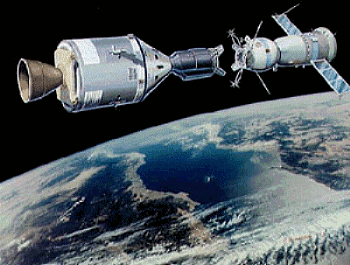Apollo-Soyuz Test Project

An Apollo Command and Service module docked with a Soyuz spacecraft at an altitude of 225 kilometers.
The Apollo-Soyuz Test Project was the first international manned spaceflight and a symbolic end to the nearly 20-year-long Space Race between the United States and the Soviet Union. Casting political differences temporarily aside, the two superpowers successfully completed the first joint on-orbit manned space operation. ASTP negotiations began in 1970, and an agreement for ASTP flight operations was signed at the superpower summit in May 1972.
This was the last manned spaceflight by the United States using a traditional rocket booster, and the last American manned spaceflight prior to the start of the Shuttle program.
Technical objectives
The mission was designed primarily to establish and test space-based rescue techniques needed by both the American and Soviet manned space programs. Science experiments would be conducted, and logistics involved in carrying out joint space operations between the two nations developed and refined, paving the way for future joint ventures with the Space Shuttle and International Space Station.
As the American and Soviet space capsules were incompatible, a new docking module had to be developed with a Soviet configuration on one side and an American configuration on the other. This module also acted as an airlock and transfer facility, allowing astronauts and cosmonauts to become accustomed to the atmospheres of each other's vehicles. Should the cosmonauts have attempted an immediate transfer to the Apollo craft, they would quickly have suffered from the bends.
Language problems
Other differences, such as language, were not so easily resolved. The cosmonauts and astronauts agreed to communicate with their respective mission controllers in their native tongues. In-flight communications between the crews would be handled in any way deemed practical at the time. National pride also came into play: Americans referred to the mission as the Apollo-Soyuz Test Project, Soviets as the Soyuz-Apollo Test Project.
Language differences led to several humorous misunderstandings between the astronauts and cosmonauts. Years after the ASTP, the Commander of the Soviet crew, Aleksei Leonov, said that three languages were used on the mission, Russian, English, and "Oklahomski". This was a reference to the American Commander, Thomas Stafford, who was born in Oklahoma and struggled to understand Russian.
Mission events
The Soyuz 19 spacecraft was launched about seven hours ahead of the Apollo ASTP. Using techniques perfected during previous manned flights, the Apollo craft separated from its spent S-IVB booster, turned around, and docked with the ASTP docking module attached to the S-IVB. Then the Apollo spacecraft chased the Soyuz spacecraft to a rendezvous, completing a docking at 12:10 pm EDT on 17 July 1975. Stafford and Slayton entered the docking module and adjusted the air pressure inside, and finally, in an event broadcast live on global television, the two cosmonauts entered through their side of the docking module and shook hands with the waiting astronauts.
The two crews conducted experiments together, shared each other's accommodations and meals, and took part in a variety of press conferences and other live broadcasts. Messages were relayed from the crews directly to President Ford and Premier Brezhnev. The two spacecraft remained docked for two days, then undocked and re-docked for practice purposes, before returning to Earth. Soyuz 19 landed in Russia on 21 July while the Apollo craft remained in space another three days to conduct more on-orbit experiments.
Near-disaster at splashdown
At splashdown a tragedy was only narrowly averted. Difficulties with communications following reentry had distracted Brand so that he forgot to operate the two Earth landing system switches that would deploy the parachutes and deactivate the thrusters. When the drogue 'chute failed to come out, Brand manually commanded it to deploy, but the swinging of the spacecraft triggered the still-armed thrusters to fire to correct the oscillations. Stafford noticed this and shut them down, but by then the thrusters' nitrogen tetroxide propellant was boiling off and entering the cabin via a pressure-relief valve. So much of the highly toxic gas was drawn in to the capsule that the astronauts started to choke. Then the Command Module hit the water, "like a ton of bricks" Stafford said, and turned upside-down. Stafford grabbed the oxygen masks from a locker but by the time he reached Brand, the Command Module pilot was unconscious. Later examination showed that the fast-acting gas had blistered the astronauts' lungs and turned them white.
Doctors also discovered a shadow on an X-ray of one of Slayton's lungs and, fearing cancer, decided to operate. Fortunately, it proved to be a benign tumor; but had the shadow been found before the flight, Slayton, who had been grounded during the Mercury Project with a heart problem, would probably have prevented from going into space at all.
| Apollo spacecraft | Soyuz 19 spacecraft | |
| launch date | Jul 15, 1975 | Jul 15, 1975 |
| launch vehicle | Saturn IB | Soyuz |
| crew | Commander: Thomas Stafford Command Module pilot: Vance Brand Docking Module pilot: Donald Slayton |
Commander: Aleksei Leonov Flight engineer: Valeri Kubasov |
| mission duration | 9 days 1 hour | 5 days 23 hours |
| splashdown | Jul 24, 1975 | Jul 21, 1975 |



